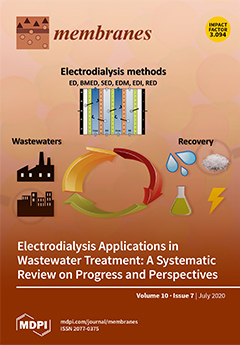The present work reports the performance of three types of polyethersulfone (PES) membrane in the removal of highly polluting and toxic lead Pb
2+ and cadmium Cd
2+ ions from a single salt. This study investigated the effect of operating variables, including pH,
[...] Read more.
The present work reports the performance of three types of polyethersulfone (PES) membrane in the removal of highly polluting and toxic lead Pb
2+ and cadmium Cd
2+ ions from a single salt. This study investigated the effect of operating variables, including pH, types of PES membrane, and feed concentration, on the separation process. The transport parameters and mass transfer coefficient (k) of the membranes were estimated using the combined film theory-solution-diffusion (CFSD), combined film theory-Spiegler-Kedem (CFSK), and combined film theory-finely-porous (CFFP) membrane transport models. Various parameters were used to estimate the enrichment factors, concentration polarization modulus, and Péclet number. The pH values significantly affected the permeation flux of the Pb
2+ solution but only had a slight effect on the Cd
2+ solution. However, Cd
2+ rejection was highly improved by increasing the pH value. The rejection of the PES membranes increased greatly as the heavy metal concentration rose, while the heavy metal concentration moderately affected the permeation flux. The maximum rejection of Pb
2+ in a single-salt solution was 99%, 97.5%, and 98% for a feed solution containing 10 mg Pb/L at pH 6, 6.2, and 5.7, for PES1, PES2, and PES3, respectively. The maximum rejection of Cd
2+ in single-salt solutions was 78%, 50.2%, and 44% for a feed solution containing 10 mg Cd/L at pH 6.5, 6.2, and 6.5, for PES1, PES2, and PES3, respectively. The analysis of the experimental data using the CFSD, CFSK, and CFFP models showed a good agreement between the theoretical and experimental results. The effective membrane thickness and active skin layer thickness were evaluated using the CFFP model, indicating that the Péclet number is important for determining the mechanism of separation by diffusion.
Full article






